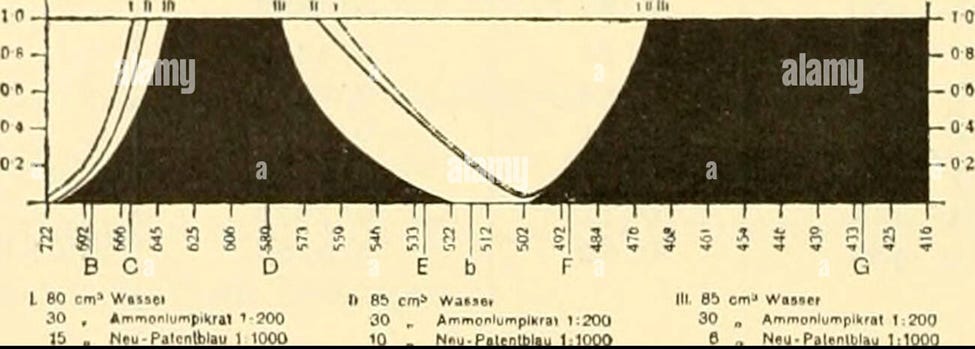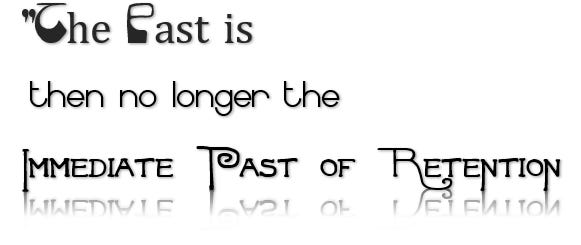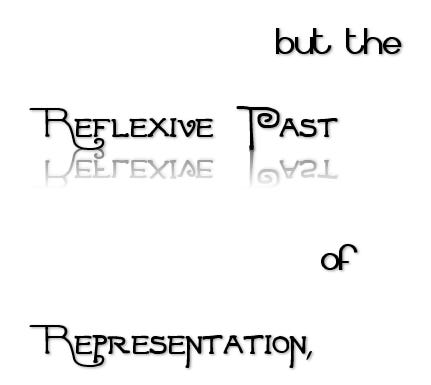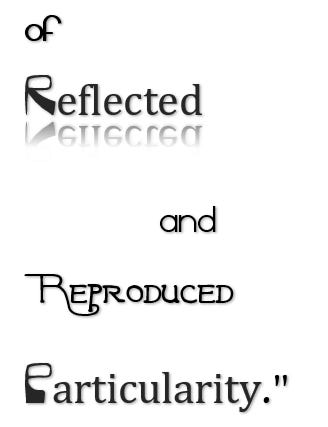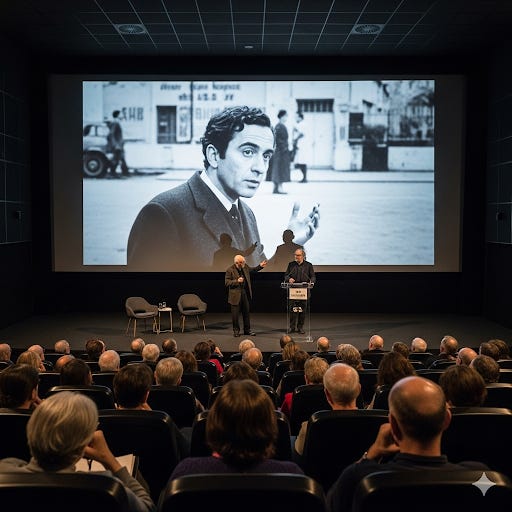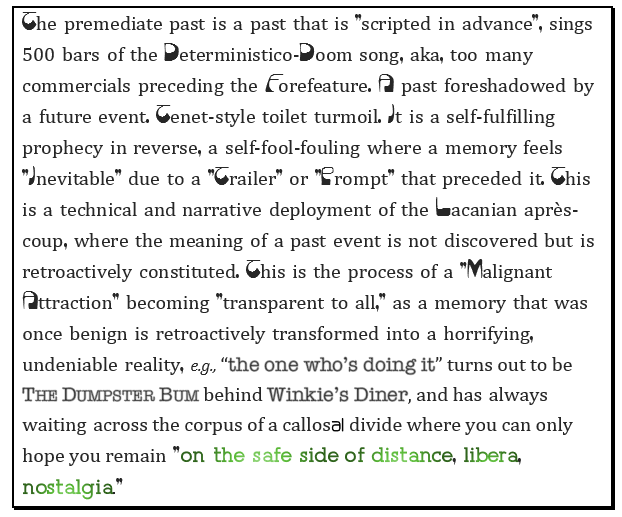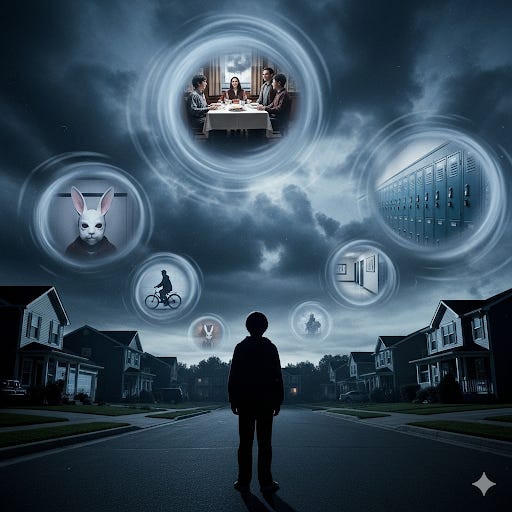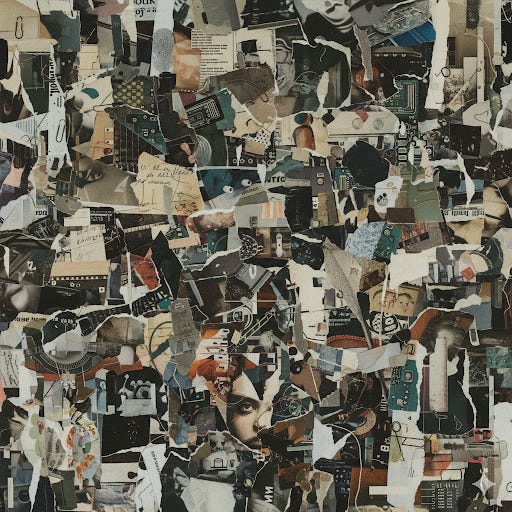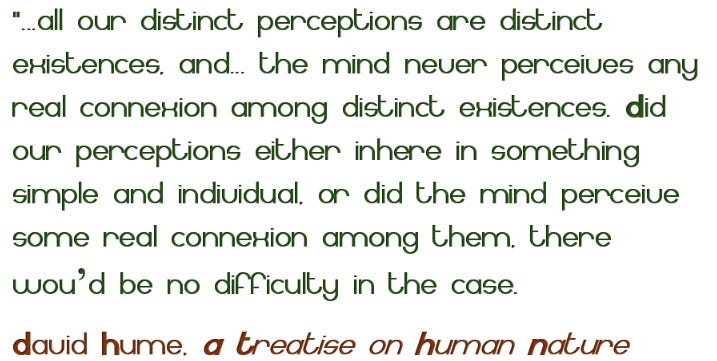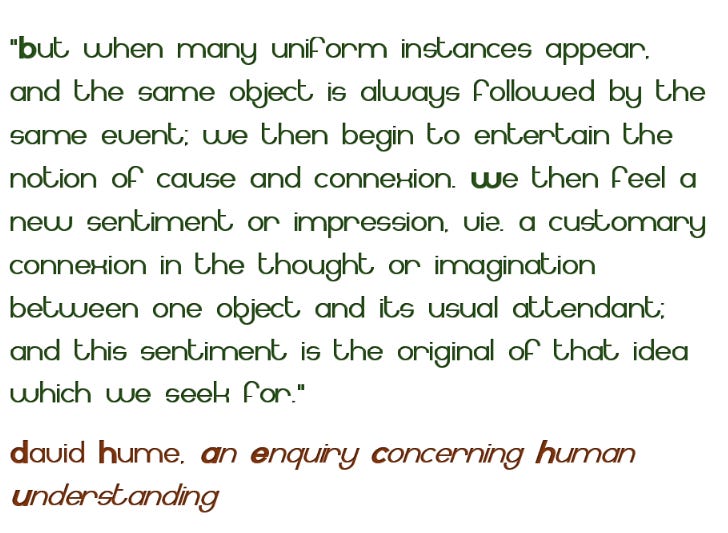Deleuzo-Deployment 1/3
The A-B-A Blues, sensitive plates, and contractile powers of Deleuze’s first synthesis
How can one repeat the same, as Nietzsche asserts, but differently. Repetition, it would be fair to assume, is more or less the same. So how can it also be the catalyst of change?
For too long I was looking for some kind of pat one paragraph answer, was directed towards Deleuze, and am only now returning from a bad case of the CaesurAbyssaI “Twilight Blues ghostly1” with the bad news that it’s a bit complicated, so I will divide this into three posts, and each will have a breakdown of the theory, followed by my own fictional or speculative or frankly, stupid (e.g., The Doomrites of the Dionysian Dityrambler) take.
So how does the same thing repeat and still produce difference? We must, to my eternal regret, start with Hume's AB-AB example, then borrow a “cup of dread” from Nietzsche, in order to find a Synthesis or three in Gilles Deleuze’s Difference and Repetition, which reveals how difference arises from the eternal same in the form of imagination. Using my own imagination, I will then apply this Deleuzean model to different frameworks to show how various scenarios are a process of repeating the same, but differently."
Those already familiar with these concepts or simply uninterested, i.e., those of you who came here to watch the Brag Duncers at the Dionysian Dithyramble, CTRL-F for
Hume’s working model: AB, AB, AB…
Imagine observing A followed by B, then again A followed by B. Hume treats each appearance as discrete and self-contained, “a perfect independence on the part of each presentation.” The sequence follows “the rule of discontinuity or instaneity in repetition,” such that “one instance does not appear unless the other has disappeared.”
Conveniently for we novelty-seekers, here “repetition disappears even as it occurs,” because, Repetition, “has no in-itself” at least that’s how it self-effacingly self-identifies.
Counting “second,” “third,” or “same” only labels positions; it does not explain why the sequence starts to feel patterned.
Hume’s brilliant advance is that the difference in the eternally repeating A-B-A-B is Expectation Itself—one comes to expect B after A where previously there was no such expectation.
To ground it in a real world example. If someone coughs, then sneezes, coughs, then sneezes, one comes to expect the sneeze after the cough, where previously there was no such expectoration.
Deleuze agrees with Hume about the discontinuous feed yet shifts the scene of this complosively-repetitive grime spree to its infect upon the receiver: “repetition changes nothing in the object repeated, but does change something in the mind which contemplates it.” What is it, then, in the mind, that changes?
He starts with Hume’s working materials, “independent identicals2” which then identicalcify into habit. Habitually, you have a strong sense the sun will rise each morning. So the world barges in on you, chaotic, random, too often drunk and eager for romance. Deleuze identifies such affronteries of the world as cases. These cases are then passively synthesized into a pure past.
To explain the change or difference that [repetition] introduces into the mind which contemplates it…[the] “difference that the mind draws from repetition.” , Deleuze introduces passive synthesis—it is “constitutive… not carried out by the mind, but occurs in the mind which contemplates, prior to all memory and all reflection.”
This is Deleuze’s First Synthesis.
Here’s a quote from Difference and Repetition both to restate the above and to move us forward.
Does not the paradox of repetition lie in the fact that one can speak of repetition only by virtue of the change or difference that it introduces into the mind which contemplates it? By virtue of a difference that the mind draws from repetition?** What does this change comprise? Hume explains that the *1* independent identical or similar cases are grounded in the imagination. The imagination is defined here as a *2* contractile power: like a *3* sensitive plate, it retains one case when the other appears like a sensitive plate, it retains one case when the other appears to contracts cases, elements, agitations or homogeneous instants and grounds these in an internal qualitative impression.
Gilles Deleuze, Difference and Repetition
What is it like to be a Sensitive Plate?
This refers to an early photographic plate called a “light sensitive plate” made of metal, then glass, coated with silver salts or, later, emulsion. When exposed to light, the plate undergoes a chemical change, capturing a latent image. This image is an invisible impression that is held or retained in the plate's emulsion until it is chemically developed.
Deleuze is clearly drawing on that cultural association—plates that hold impressions, as a metaphor for “a receptive, impressionable surface of experience like the passive, retentive quality of the imagination.
Sensitivity: the plate is passively affected by an exposure.
Retention: it holds a latent image without trying.
That metaphor is doing precise work. The imagination, like the plate, retains one case when the other appears. Successive exposures are impressed on the same surface; the plate thickens. The point is passivity.
A photographic plate does not try to remember the light; it retains the impression as a natural property of its chemical makeup. Likewise, the imagination's retention and contraction is not a conscious act of memory. It is an automatic, pre-conscious process that happens in the mind, not by the mind3.
In summary:
This happens on the plate, or to the plate; the plate doesn’t impress exposures unto itself.
This happens in the passive imagination/mind or to the passive imagination/mind, the imagination/mind does not impress the impression onto itself, hence its passivity.
The two key qualities of the plate for Deleuze's metaphor are:
Sensitivity: It is passively affected by an external event (an exposure to light).
Retention: It holds the impression of that event over time.
But where passivity is, to abuse poor Holderlin for the millionth time, also lies The
After enough AB exposures, the passive synthesizer no longer receives A on a blank slate: the present already leans toward B.
Just as a photographer could create a single image from multiple exposures on the same plate, the imagination contracts multiple repeated "cases" into one "internal qualitative impression"2. This resulting impression is the feeling of habit or expectation, which Deleuze calls a “living rule.”
Hume’s material run still obeys discontinuity; the passive synthesis gives the receiver a way to live through it. However, it is a radical inversion of the Cartesian cogito ergo sum, a synth-blaring virtual cave man clubbing the cogito over its thick skull and dragging it back to a cave of pure potential while stupid-self-singing the lyrics to the Giant crossover hit enjoyed by Giants from Gog to Magon, Laestrygonians to the Nephilim, and that stupid song is called:
Thinkers like Daniel W. Smith point out that contractile power is a key part of Deleuze's "transcendental empiricism." It's not just how we happen to associate ideas; it is the very condition that makes the experience of a unified present possible.
Time from contraction: the “immediate past” of retention
This contractile event is where Deleuze locates the genesis of time: Time is constituted only in the originary synthesis which operates on the repetition of instants.nIn that span, “the preceding instants are retained in the contraction,” giving the present a small but real depth. Deleuze names this depth the immediate past of retention—a pre-reflective remainder of the just-was that still weighs on the now. This retained remainder makes expectation possible before any act of explicit remembering. It is here that “it is in this present that time is deployed.”
Deleuze is more precise and agile than I had presumed. He has ruffled through Hume’s scented garments, but not defiled them, only deployed something new into them. Hume’s construct holds true after Deleuze has his way with it: each presentation enjoys “a perfect independence on the part of each presentation,” and the material run obeys “the rule of discontinuity or instaneity in repetition,” such that “one instance does not appear unless the other has disappeared.” Deleuze even names this as “the state of matter which produces one case only when the other has disappeared.” The contractile event does not erase that structure; it gives the receiver a way to live3 through it.
The first synthesis bridges towards the second:
on the basis of the qualitative impression in the imagination, memory reconstitutes the particular cases as distinct, conserving them in its own 'temporal space'. The past is then no longer the immediate past of retention but the reflexive past of representation, of reflected and reproduced particularity.*
Okay enough with the repetitive handwringing, bring on the:
Philosophical Nonsense Questions
On the one hand, I somewhat compulsively rhyme things. On the other, a set of rhymes is a distinct set of constraints that foists forth strange emergences. This isn’t all that novel of a rhyme set, as almost all words are just modifications of mediate, except for mediante. “Immediate Past” happened to yield some particularly fulsome rhymes that modify in all senses of that word, the past as it has been considered above.
Glossary of Novel Temporal Concepts
Mediate Past
The mediate past is a past that is actively transformed and structured by a conscious, intentional subject. Unlike the passive, pre-conscious synthesis of the Intermediate Past, the mediate past is not simply a memory that crystallizes; it is one that is given meaning and purpose through a deliberate act of reflection. It is a "past for us," a representation that "archives and names particulars" in a way that serves a present goal. This is the stage where the subject, having gone through the initial passive syntheses of habit and memory, now takes an active, "creative" role in constructing their own narrative. It is a form of "ontological engineering," where the subject deliberately re-organizes and names the past to make sense of the present and forge a future.
ChatGPT Vagaries for Mediate Past
Method: The mediate past uses a form of "hermeneutic proofs-of-work," where the past is not simply recalled but is actively interpreted and given new meaning through a deliberate and often difficult process. This process is akin to a form of "ontological surgery," where the subject "restores, annotates, and formats" a memory to make it "right again."
Payoff: The payoff is the conversion of a raw, meaningless past into an "actionable timeline." The subject moves beyond being a passive victim of their past and becomes an active agent, creating a functional narrative that allows them to move forward. This process doesn't pretend to a "full recovery" but gives the subject a sufficient understanding to make a new future.
Risk Profile: The risk of this past is the potential for "procedural myth" or "self-delusion," where the subject's desire for a clean narrative leads them to oversimplify or falsify the past. The act of "editing" can become an act of denial, where painful truths are "pared down to the bare minimum" to achieve a desired resolution, as seen in the "expediate past." The distinction between "remediation" and "expedition" is a fine one, resting on the ethical intent of the subject
Mediante Past
The mediante past is a past that is not directly experienced, but is given meaning by an intermediary. It’s a past that arrives “by means of” something—a film, a witness, a philosophical idea, or a technological device. The medium itself co-authors the recollection, coloring it with its own inherent qualities or “grain.” This process is tied to two key concepts:
Music Theory: From the Italian/Spanish mediante, it refers to the third scale degree, the note halfway between the tonic and dominant. This suggests the mediante past is a memory that is not the absolute beginning or end, but a transitional, structuring element that links a past event (tonic) to a present outcome (dominant). It is a crucial, yet subordinate note in the melody of a life, giving harmony and direction to the entire composition.
Legal / Scholarly English: From Spanish, it is often translated as “by means of,” “through,” or “via.” This reinforces the idea of the mediante past as being accessed indirectly. It is a past that can only be understood via an agreement with an external force—the “agreement” of a film’s narrative or a witness’s testimony.
The mediante past functions as a form of the crystal image, where lived duration condenses into a reproducible image. The film, as the intermediary, creates a single image from the chaotic flow of perception, turning a pre-conscious experience into a distinct, recallable memory. This is the process where a "lived duration condenses into an image," making the past legible by creating stable images from noise.
ChatGPT Vagaries for Mediante Past
Baseline relation: Sits downstream of the immediate past of retention. The intermediary stabilizes and formats the trace into a coherent narrative, allowing it to enter memory’s reflexive space and be treated as a verifiable event.
Diagnostic: To diagnose a mediated past, name the mediator, then its bias (the specific angle, frame rate, or platform algorithm). Ask: what vanishes or gets distorted when this mediator is removed? The memory's apparent coherence and certainty often dissolve, leaving only fragmented, raw data.
Failure mode: The catastrophic failure mode is mistaking the mediator’s affordances for the event’s truth (medium-induced certainty). The subject mistakes the cinematic clarity of a memory for its historical fidelity, leading to a false sense of closure or understanding.
Expediate Past
The expediate past is a past that is retroactively streamlined and made to happen more quickly by an intentional or programmatic act. It is a memory that is pushed into a state of "triage," becoming a "procedural, throughput-first recollection".
ChatGPT vagaries
Operational cue: Track the compression ratio (how much detail is pared down to the bare minimum) versus the decision gain (what speed-up or simplified resolution the narrative provides).
Risk profile: The primary risk is a drift into procedural myth—clean, streamlined narratives that work operationally yet mislead historically. This is how institutional or personal traumas are glossed over in favor of a clean, functional timeline.
Ethical guardrail: To prevent this, keep a detailed audit trail of what was dropped and why, and make sure the “residual uncertainty” is clearly flagged and documented.
Survival Strategy: Keep a gas can with you in case you get stranded on the side of The Road.
The Premediate Past
ChatGPT vagaries
Identification: locate the prompt that primes expectation; then show how subsequent selection pressures fit the “script.”
Cross-check: seek counterfactuals that the prompt occluded; if their recall is systematically weak, premediation is active.
Use-case: clarifies why later shocks can reorganize earlier memories without altering the facts.
Remediate Past
The remediate past is a past that is actively corrected, improved, or healed. It is a past that is "refashioned across media," through acts of "restoration, annotation, and format-shifts" that "write fresh layers of representation and renew legibility". This is a creative and ethical act, a form of "ontological surgery" where the goal is to make a past event "right again" by re-inscribing it with a new, life-affirming meaning. This concept applies to a form of temporal engineering where the complexities and contingencies of a past event are simplified or resolved to serve a present goal. The Prisoner’s Cinema seek to build a coherent reality from the chaotic "frames" of the post-caesurnal trauma, editing collective traumatic memories to sharpen their resolutions.to remediate the Ricœurant horror of history by making MensMomenteAIlussions to The Way We Were, before the Shadows Fall For All Mankind.
ChatGPT vagaries
Cue: The presence of an existing but problematic narrative. This is the memory as a "lived duration that has already condensed into an image," but the image is corrupted or painful. The process is one of restoration, annotation, and re-formatting.
Practice: The active manipulation of an existing trace. The subject or collective body uses a new medium (like film) to "write fresh layers of representation and renew legibility" on a past that is already formed.
Value: This is a creative and ethical act. The goal is to move beyond simply remembering and to actively transform a traumatic past into a manageable or even productive narrative, rather than being a passive victim of it.
Intermediate Past
This is neither the "immediate past of retention" (the raw, pre-conscious echo of an instant) nor the "reflexive past of representation" (the conscious, reproducible memory). It is a transitional state where the chaotic flow of perception begins to crystallize into distinct, recallable memories.
This is the transitional state between the chaotic disintermediate past and conscious memory. It is neither the raw, pre-conscious echo of an instant (immediate past of retention) nor the conscious, reproducible memory (reflexive past of representation). This is the pre-reflective stage where the chaotic flow of perception begins to crystallize into distinct, recallable memories. This is where "lived duration condenses into a reproducible image".
ChatGPT vagaries
Cue: The diffusion of stable images from noise. This is the moment a singular event begins to emerge from a blur of perception, making naming possible, though the name remains plastic and open to change.
Practice: Pause before cataloging—let multiple sound-images compete for prominence in the
ImagineriuMysterium. Premature morpheme-labeling freezes the frame of theThe Crystalline ImageRegimetoo early.Value: This is the ideal zone for insight-generation and reframing. By actively engaging with the past at this stage, the subject can move from being a passive recipient of trauma to a creative agent of their own history.
Disintermediate Past
The disintermediate past is a past that is reached through the "shortest channel," where all intermediaries have been stripped away. It is a raw, unmediated past of pure, discontinuous data, where "filters fall away" and "proximal traces speak with minimal formatting". This revelation of an unthinkable discontinuous world, is the catastrophic state of matter that Deleuze calls mens momentanea, a world of disconnected instants without the synthetic activity of a mind to hold them together.
I’d suggest the problem is that even to anticipate the “date of total anticipated reality collapse" is the ultimate act of disintermediation, as it removes the collective synthesis that holds the world together, leaving humanity adrift in a sea of meaningless frames.
Hence the Prisoner’s Cinema operational mandate: to consciously re-synthesize a meaningless chaos of discrete, repeating particulars (the "frames") using the only functional model left, the cinematic apparatus, the last lone ontological co-ordinate system available to all after the death of God : a machine that actively positions the spectator, constructing the gaze of a transparent world without past and organizing their perception of time and space as a a mensmomentaIetheia, which like any unconcealing is “always a type of robbery,4” but a robbery that “brings us closer to being” as “a way of revealing,” and “a way of bringing forth,5” the unhiddenness of disconnected instants.
ChatGPT vagaries
Symptom: loss of continuity markers (before/after collapses into shards).
Symptom: The loss of all continuity markers, where before/after collapses into shards. This is the “meaningless chaos of discrete, repeating particulars” that the Prisoner’s Cinema must re-synthesize.
Safety protocol: To survive this state, reintroduce minimal mediation—timestamping, graffiti tagging (for example, using “Ariel tags” from the deployment logs), narration, shared indexing—to rebuild a tolerable span.
Research stance: Treat outputs as noisy shards (e.g., “brag duncers” best left ignored) and seek corroboration before inference.
The NP-intermediate past
NP-intermediate past is a past that is computationally difficult to retrieve, but not impossible. This "complexity-tier past" resists simple memory recall, presenting itself as a puzzle or a labyrinth that requires significant effort to reconstruct.
It's a past that cannot be easily accessed, but can be given form and meaning through a conscious and methodical effort akin to a sort of ontological, spiritual, and psychological proof of work on par with solving a cryptographic puzzle.
Retrieval of the NP-intermediate past relies on "caches of hidden witnesses, hermeneutic proofs-of-work" to succeed. This process is a direct contrast to the instantaneous recall of memory in the pure past, and the raw, unmediated data of the disintermediate past. The past can be restored, but it is not for the faint of heart or computationally under-resourced.
ChatGPT vagaries ranging on the usual meaning scale of 0 to infinite:
Method: Build an index first (of events, actors, artifacts), then run verification passes against it. Cache partial reconstructions to avoid having to start from scratch if the process fails.
Stop-rule: Accept “sufficient proof” thresholds to avoid infinite digging. Document residual uncertainty to prevent a false sense of total recovery.
Payoff: Converts inaccessible material into actionable timelines by giving it a name and an outline, without pretending to full recovery. This allows the subject to move forward with a functional, if incomplete, narrative.
Preview of Upcoming Posts
The Three Syntheses (Brief Preview)
—our topic here and now, it must at least appear.
This is the material, pre-conscious world where repetition simply exists without being recognized. As your notes state, it has "no in-itself" because it vanishes as it occurs. This synthesis is passive, happening in the mind to create a "larval self" that is a product of habit, not a pre-existing subject.
as a virtual, coexisting archive that grounds the present (next post).
The Past "For-Itself” Here, the past is no longer a passive trace but a "pure past" that exists "for-itself." It is a vast, virtual archive of all that has been, coexisting with the present and existing independently of any conscious subject. This is the condition for memory, a realm of possibilities waiting to be actualized.
that fractures the subject, and forces selection. (Post Three)
This final synthesis is the active, creative "cut" that judges and selects from the pure past. The Eternal Return is not a loop of the same, but a radical process of affirming what will be. This is where a new present and future are forged, and the world is given meaning "for us" to control and shape. The For-us becomes a representation that "archives and names particulars," a way of actively creating a new reality from the chaos.
Holderlin, by way of Heidegger’s Language in the Poem
More on Independent Identicals
The term is Deleuze's own synthesis of Hume's position. It refers to the two crucial characteristics of the perceptions that form the basis of our idea of causality: first, that each perception is a radically separate and distinct event (independent), and second, that a habit can only be formed through the repetition of similar or uniform instances (identical).
The Independent Aspect: According to Hume, we never perceive a direct connection between two events, only that they happen in a succession. Each event is a "distinct existence, independent of all others."
The Identical Aspect: The mind is only prompted to create a connection when it observes the repetition of events that are similar. This uniformity allows our imagination to form a habit or an expectation that a certain event will follow another.
The product of these contractions Deleuze calls The Larval Self: a nascent subject that is the product of these very contractions, not their pre-existing supervisor. The concept of a "larva" is not incidental; it signifies a developmental stage, implying that the self is not a static substance but a dynamic process of becoming. This stands as a direct challenge to the entire Cartesian tradition that begins with a pre-existing, self-identical subject.
Martin Heidegger, Being and Time
Martin Heidegger, The Question Concerning Technology





